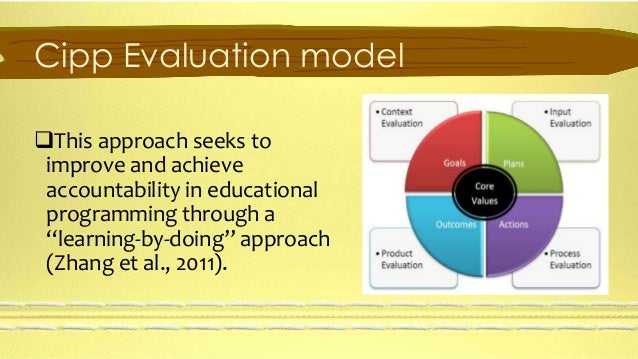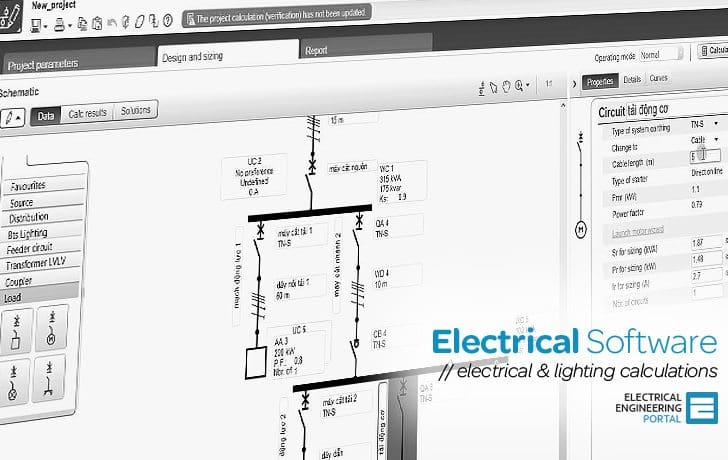- Programas Gratis
- Cipp Evaluation Model In Education
- Cipp Evaluation Model Program Free Software And Shareware Development
- Cipp Model Of Nursing Evaluation
- The CIPP Model is a useful decision-making framework that helps make special library training more effective. Software Solutions. Integrated Library Systems. SydneyEnterprise Large, multinational or multibranch; GeniePlus ILS essentials for agile libraries; Knowledge Management.
- General steps that were proposed by Stufflebeam: A. Focusing the Evaluation B. Collection of Information C. Organization of Information D. Analysis of Information E. Reporting of Information F. Administration of the Evaluation Process evaluation What are the general steps for.
- This chapter introduces the CIPP Model by presenting a general scheme to show relationships among the model's key components. Next, evaluation is defined. The chapter subsequently delineates the CIPP Model's improvement/ formative and accountability/summative roles. It follows with a brief discussion of self-evaluation applications of the model.
This is a listing of computer programs with applications in structural geology and tectonics available on the world-wide web. Most are freeware or low-cost shareware. If you know of additional software that should be listed here, please send e-mail to geotech@smith.edu.
The purpose of this program evaluation was to examine the four components of the CIPP evaluation model (Context, Input, Process, and Product evaluations) in the diversity training program conceptualization and design delivered to College of Education K-12 preservice teachers at a large university in the southeastern United States (referred to in. “The CIPP Evaluation Model: How to Evaluate for Improvement and Accountability” is a clear, systematic explanation of the Context, Input, Process, Product (CIPP) model of evaluation developed by Daniel Stufflebeam. What I appreciate about this model is that it challenges evaluators to focus on a program’s real, substantive impact with.
Programas Gratis
Allmendinger’s Archives*** Highly Recommended Site ***
Archive of programs for the Macintosh written by Richard Allmendinger of Cornell University in Ithaca, New York. Includes a stereonet plotting program, a fault kinematics program, a microstructural analysis program, and several structural geology teaching programs.
A Windows version of the Stereonet program is now available.
Nestor Cardozo Programs *** NEW ***
OSXGeoCalc: A structural geology calculator
OSXBackstrip: Backstripping of sedimentary strata
OSXFlex2D: 2D Flexural modelling
All are freeware and require Mac OS X v10.3.9 (Panther) or Mac OSX v10.4 (Tiger)
- COGS
The Computer Oriented Geological Society maintains archives of DOS and Macintosh programs of interest to geologists.
Computers & Geosciences
Source code for programs published in the journal Computers & Geosciences.

Detach (Europe download) (USA download)
Software to construct detachment folds formed by different amplification mechanisms. The software is for free and it is an Excel spreadsheet that can be used in both PC and Macintosh platforms.
DotProc – Geoscientific Analysis Software
DotProc software is designed to help geoscientists in the analysis of two-dimentional (2D) spatial data sets in a highly visual manner. Quick and easy decisions about large numbers of data points can be made without the necessity of much mathematical skill.

Finite Element
Archive of thin-plate and thin-shell finite element programs written by Peter Bird at the University of California in Los Angeles (UCLA).
FMSI
The Focal Mechanism Stress Inversion program for the Macintosh written by John Gephart at the Institute for the Study of the Continents (INSTOC) in Ithaca, New York.
Folding
A high-amplitude folding simulations program for DOS written by Kenneth Cruikshank at Portland State University in Oregon (Journal of Structural Geology15:79-94).
Fry Method I
A strain analysis program for DOS by Laurent Aillères and Michel Champenois (Journal of Structural Geology16:1327-1330).
GAEA Technologies
GAEA Techologies develops and markets software for borehole logs, cross-sections, grain-size analysis, contaminant transport modeling and landfill design.
Cipp Evaluation Model In Education
Geotechnical Software
A large directory of software for geotechnical engineering, data analysis, and data visualisation. Some shareware, but most of the programs are commercial.
Gustavo Tolson — Structural Software
This is a set of public domain structural geology programs written by Dr. Gustavo Tolson and his research group at the Universidad Nacional Autonoma de Mexico.
Mathematica Demos
Download Mathematica notebooks demonstrating time-dependent effects of heat advection and topography during erosion from Bernhard Grasemann at Vienna University in Austria.
Oriana
A program to perform orientation analysis of circular data in Windows written by Waren Kovach at Kovach Computing Services in Anglesey, Wales.
Orient
A stereographic projection and structural domain analysis program for DOS written by Frederick Vollmer at the State University of New York at New Paltz.
PaleoMag
A paleomagnetic data analysis package for the Macintosh by Craig Jones of Cooperative Institute for Research in Environmental Sciences (CIRES) at the University of Colorado in Boulder.
Paleostress
An archive of programs for the analysis of fault-slip data on the Macintosh (and a few for SUN sparc stations) from Bernard Celerier of the University of Montpellier in France. Documented software deals with fault and slip data/graphic representation/analysis/stress inversion and core structural measurements. Undocumented software deals with focal mechanisms and borehole logging data.

Poly3D
Ploy 3D (Thomas, 1993) is a 3D boundary-element code that provides solutions to boundary value problems of continuum mechanics. Slip distributions on faults subject to tectonic loading can be calculated, as well as the stress and displacement fields around the faults. Developed by the Structural Geology and Geomechanics Group at Stanford University.
Rake
Download a Visual Basic program, written by Louvari Eleni of the Geophysical Laboratory at the Aristotle University of Thessaloniki in Greece, for earthquake focal mechanism analysis (Computers & Geosciences23:851-857).
Rampe
Download a Macintosh program from Eric Mercier of the Université de Nantes in France for forward modeling of several different types of ramp-related folding.
Rose
A rose diagram plotting program for Windows written by Todd Thompson of the Indiana Geological Survey in Bloomington.
ScienceProf.com
Company run by Declan DePaor and Carol Simpson providing web- and PC-based teaching and research resources from K-12 through Ph.D. Click here to download a free evaluation copies of Dr. DePaor’s new Structural Analysis course on CD ROM.

Cipp Evaluation Model Program Free Software And Shareware Development
SoftStructure
A collection of structural analysis programs for DOS written by Ze’ev Reches at Hebrew University in Israel.
Softree
Offers a downloadable freeware beta version of its Terrain Tools surveying and mapping software.
SpheriCAD
An AutoCAD utility for plotting structural orientation data written by Carl Jacobson at Iowa State University has been updated to a VBA package for AutoCAD 14 (and higher) by John P. Baldwin. Another program (ChronoMag VB) is also available to plot and perform statistical analyses on paleomagnetic and geochronologic age data.
StereoPro
A Windows stereonet program written by Martin Walters at Racal Defence Electronics Limited. Version 1.0 can be downloaded freely.StereoNett
A stereographic projection program for Windows written by Johannes Duyster at Ruhr University in Bochum, Germany.
Stereoplot
A stereographic projection program for the Macintosh written by Neil Mancktelow at ETH-Zentrum in Zürich, Switzerland.
Structural Geology, Mapping, and GIS Software *** Highly Recommended Site ***
This site contains Windows programs written by Rod Holcombe at the Department of Earth Sciences at the University of Queensland in Australia. Software includes GEOrient (stereonets and rose diagrams), GeoCalculator (structural geometry calculator), GeoFryPlots (Fry strain analysis), and others.
Structural & Tectonics Software
This site is maintained by the Structural Geology and Tectonics Department at the University of Amsterdam and contains links to numerous programs of interest to structural geologists and tectonists (some are also accessible from this page, while others are new).
TectonicsFP
A 32-bit Windows software package for plotting all types of structural data (including paleostress analysis) written by Franz Reiter and Peter Acs at the University of Innsbruck in Austria.
Visualizing Stress & Strain
Download programs by Nathaniel Reish and Gary Girty at San Diego State University for teaching basic stress and strain theory.
WinTek
A structural analysis program for Windows written by Andreas Peterek and Stefan Krumm at the University of Erlangen in Germany.
CIPP evaluation model is a Program evaluation model which was developed by Daniel Stufflebeam and colleagues in the 1960s. CIPP is an acronym for Context, Input, Process and Product. CIPP is an evaluation model that requires the evaluation of context, input, process and product in judging a programme’s value. CIPP is a decision-focused approach to evaluation and emphasises the systematic provision of information for programme management and operation.[1]
CIPP model[edit]
The CIPP framework was developed as a means of linking evaluation with programme decision-making. It aims to provide an analytic and rational basis for programme decision-making, based on a cycle of planning, structuring, implementing and reviewing and revising decisions, each examined through a different aspect of evaluation –context, input, process and product evaluation.[1][2]
The CIPP model is an attempt to make evaluation directly relevant to the needs of decision-makers during the phases and activities of a programme.[1] Stufflebeam’s context, input, process, and product (CIPP) evaluation model is recommended as a framework to systematically guide the conception, design, implementation, and assessment of service-learning projects, and provide feedback and judgment of the project’s effectiveness for continuous improvement.[1]
Four aspects of CIPP evaluation[edit]
These aspects are context, inputs, process, and product. These four aspects of CIPP evaluation assist a decision-maker to answer four basic questions:
- What should we do?
This involves collecting and analysing needs assessment data to determine goals, priorities and objectives. For example, a context evaluation of a literacy program might involve an analysis of the existing objectives of the literacy programme, literacy achievement test scores, staff concerns (general and particular), literacy policies and plans and community concerns, perceptions or attitudes and needs.[1]
- How should we do it?
This involves the steps and resources needed to meet the new goals and objectives and might include identifying successful external programs and materials as well as gathering information.[1]
- Are we doing it as planned?
This provides decision-makers with information about how well the programme is being implemented. By continuously monitoring the program, decision-makers learn such things as how well it is following the plans and guidelines, conflicts arising, staff support and morale, strengths and weaknesses of materials, delivery and budgeting problems.[1]
- Did the programme work?
By measuring the actual outcomes and comparing them to the anticipated outcomes, decision-makers are better able to decide if the program should be continued, modified, or dropped altogether. This is the essence of product evaluation.[1]
Using CIPP in the different stages of the evaluation[edit]
The CIPP model is unique as an evaluation guide as it allows evaluators to evaluate the program at different stages, namely: before the program commences by helping evaluators to assess the need and at the end of the program to assess whether or not the program had an effect.
CIPP model allows you to ask formative questions at the beginning of the program, then later gives you a guide of how to evaluate the programs impact by allowing you to ask summative questions on all aspects of the program.
- Context: What needs to be done? Vs. Were important needs addressed?
- Input: How should it be done? Vs. Was a defensible design employed?
- Process: Is it being done? Vs. Was the design well executed?
- Product: Is it succeeding? Vs. Did the effort succeed?
References[edit]
- ^ abcdefghRobinson, B. (2002). The CIPP has its formation from the earlier stages where there were no paragraphs or any acronyms for any product or stanzas. The CIPP approach to evaluation.Collit project: A background note from Bernadette
- ^'Implementation of CIPP Model for Quality Evaluation at School'(PDF).
Cipp Model Of Nursing Evaluation
